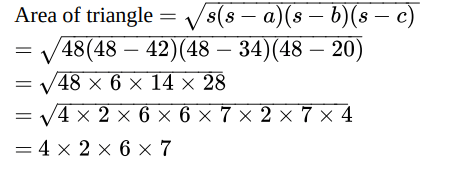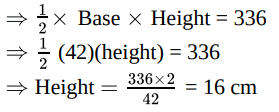Half Yearly Class 9 Mathematics Set 3 (Solutions) | Mathematics (Maths) Class 9 PDF Download
Time: 3 Hours
Maximum Marks: 80
General Instructions:
(i) The question paper comprises four sections: A, B, C, and D.
(ii) All questions are compulsory. However, internal choices are provided in some questions.
(iii) Section A has 10 Questions carrying 1 mark each.
(iv) Section B has 5 Questions carrying 2 marks each.
(v) Section C has 10 Questions carrying 3 marks each.
(vi) Section D has 5 Questions carrying 6 marks each.
(vii) Use of calculators is not permitted.
Section A
Q1. Is √8 rational or irrational? (1 Mark)
Ans: √8 = 2√2, irrational as √2 is irrational.
Q2. What is the degree of a zero polynomial? (1 Mark)
Ans: Zero polynomial: degree undefined or −∞.
Q3. What is the y-coordinate of a point on the x-axis? (1 Mark)
Ans: On x-axis, y-coordinate is 0.
Q4. If x − 2y = 4, what is y when x = 0? (1 Mark)
Ans: x − 2y = 4, x = 0: −2y = 4 ⇒ y = −2
Q5. State Euclid’s fourth postulate. (1 Mark)
Ans: Euclid’s fourth postulate: All right angles are equal.
Q6. If ∠A = 60° in △ABC and AB = AC , what is ∠B? (1 Mark)
Ans: AB = AC implies ∠B = ∠C.
Then, 60° + 2∠B = 180°
⇒∠B = 60°
Q7. Simplify: √75. (1 Mark)
Ans: √75 =
Q8. If p(−1) = 0 for p(x) = x2 + kx − 3, find k. (1 Mark)
Ans: p(−1) = (−1)2 + k(−1) − 3 = 0
⇒ 1 − k − 3 = 0
⇒ k = −2.
Q9. Does the point (0, 5) lie on the x-axis or y-axis? (1 Mark)
Ans: (0, 5) lies on the y-axis.
Q10. If a transversal intersects two parallel lines, what is the sum of interior angles on the same side? (1 Mark)
Ans: Sum of interior angles on the same side is 180°.
Section B
Q1. Rationalize:  (2 Marks)
(2 Marks)
Ans:
Q2. Find the product of the zeroes of x2 − 6x + 8. (2 Marks)
Ans: For x2 − 6x + 8, product of zeroes = c/a = 8/1 = 8.
Q3. Find the distance between A(0, 2) and B(3, −2). (2 Marks)
Ans: Distance:
Q4. Solve 4x + y = 10 for x when y = 2. (2 Marks)
Ans: 4x + y = 10, y = 2: 4x + 2 = 10
⇒ 4x = 8
⇒ x = 2
Q5. If ∠X Y Z = 110° and X Y ∥ Z W, find the corresponding angle to ∠X Y Z. (2 Marks)
Ans: Corresponding angle to ∠X Y Z = 110° is 110°.
Section C
Q1. Prove that √2 is irrational. (3 Marks)
Ans: Assume √2 = a/b, a, b coprime. Then, 2 = a2/b2 ⇒ a2 = 2b2.
So, 2 divides a.
Let a = 2k. Then, 4k2 = 2b2
⇒ b2 = 2k2, so 2 divides b.
Q2. Find the zeroes of x2 − 3x − 10. (3 Marks)
Ans: x2 − 3x − 10 = (x − 5)(x + 2) = 0. Zeroes: x = 5, −2.
Q3. Find the area of the triangle formed by points A(1, 2), B(4, 2), C (2, 5). (3 Marks)
Ans: Area: 1/2| 1(2 - 5) + 4 (5 - 2) + 2 (2 - 2) = 1/2 |- 3 + 12 + 0| = 9/2sq.
Q4. Solve: x + 2y = 7 and 3x − y = 4 graphically. (3 Marks)
Ans: For x + 2y = 7: (7, 0), (1, 3).
For 3x − y = 4: (2, 2), (1, −1).
Intersection: x = 3, y = 2.
Q5. Using Euclid’s postulates, prove that every line segment has a unique midpoint. (3 Marks)
Ans: Take points A and B. By Euclid’s postulates, draw line AB. Construct perpendicular bisector using equal circles (postulate 3). It intersects AB at one point (unique midpoint).
Q6.In △DEF, if DE ∥ FG and ∠D = 45°, find ∠EFG (3 Marks)
Ans: Since DE ∥ FG, ∠EFG = ∠D = 45°(corresponding angles).
Q7. Find k such that 2x2 + kx + 5 has equal roots. (3 Marks)
Ans: Discriminant: k2 − 4 · 2 · 5 = 0
⇒ k2 = 40
⇒ k = ±2√ 10.
Q8. Express  as a fraction. (3 Marks)
as a fraction. (3 Marks)
Ans:
Subtract: 90x = 15
⇒ x = 15/90 = 1/6
Q9. Solve: 5x − 2y = 8 and x + y = 4 using graphical method. (3 Marks)
Ans: For 5x − 2y = 8: (2, 1), (0, −4).
For x + y = 4: (4, 0), (0, 4).
Intersection: x = 2, y = 2.
Q10. Find the area of the triangle whose sides are 42 cm, 34 cm and 20 cm in length. Hence, find the height corresponding to the longest side. (3 Marks)
Ans: Let:
By Heron's formula, we have:
Area of triangle = 336 cm2
We know that the longest side is 42 cm.
Thus, we can find out the height of the triangle corresponding to 42 cm.
We have:
Area of triangle = 336 cm2
Section D
Q1. Find the quotient and remainder when x3 − 6x2 + 11x − 6 is divided by x − 1. (6 Marks)
Ans: Synthetic division: 1, −6, 11, −6 with x = 1 : 1, 1, 1 − 5, −5 + 6, 1 − 6
⇒ x2 − 5x + 6, remainder 0.
Q2. For points A(−1, 0), B(3, 0), C (0, 4), find the area of △ABC and check if it’s isosceles. (6 Marks)
Ans: Area: 1/2 |− 1(0 − 4) + 3(4 − 0) + 0(0 − 0)| = 1/2 |4 + 12| = 8 sq units.
Sides: AB = 4, AC = √17, BC = √17 Isosceles
Q3. Prove that the sum of angles in a triangle is 180° using parallel lines and a transversal. (6 Marks)
Ans: Extend BC to D, draw C E || AB. ∠BAC = ∠ACE, ∠ABC = ∠BCE (correspond-ing).
∠ACE + ∠ACB + ∠BCE = 180°, so sum is 180°.
Q4. Solve: x − y = 3 and 2x + y = 9 graphically. Find the area of the triangle formed by these lines and the y-axis. (6 Marks)
Ans: For x − y = 3: (3, 0), (0, −3). For 2x + y = 9: (4, 1), (3, 3).
Intersection: x = 4, y = 1.
Triangle vertices: (0, −3), (0, 9), (4, 1).
Area: 1/2 · 4 · 12 = 24 sq. units.
Q5. Solve: 4x + 3y = 14 and 2x − y = 2 using elimination method. Verify the solution. (6 Marks)
Ans: Multiply second by 3: 6x − 3y = 6.
Add to first: 4x + 3y + 6x − 3y = 14 + 6
⇒ 10x = 20
⇒ x = 2, y = 2.
Verify: 4 · 2 + 3 · 2 = 14,
2 · 2 − 2 = 2.
|
40 videos|560 docs|57 tests
|
FAQs on Half Yearly Class 9 Mathematics Set 3 (Solutions) - Mathematics (Maths) Class 9
| 1. What topics are typically covered in a Half-Yearly Math exam for Class 9? |  |
| 2. How can students prepare effectively for the Half-Yearly Math exam? |  |
| 3. What is the importance of solving previous years' question papers for the Half-Yearly Math exam? |  |
| 4. Are calculators allowed in the Half-Yearly Math exam for Class 9? |  |
| 5. What strategies can students use to manage their time during the Half-Yearly Math exam? |  |























